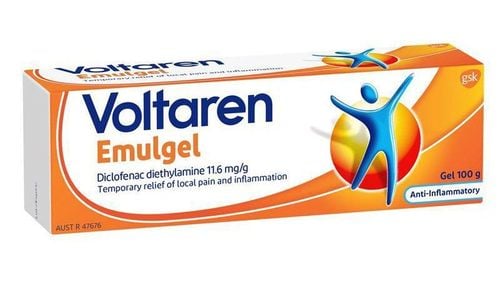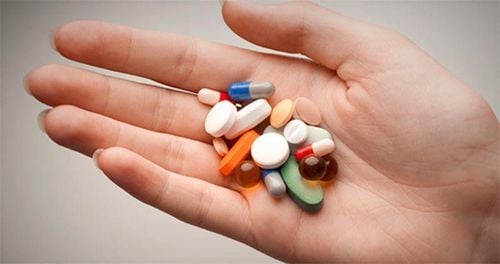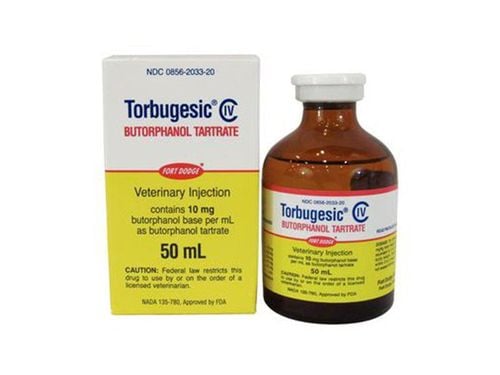This is an automatically translated article.
Paratramol is usually used mainly for cases of moderate to severe pain, such as joint pain, headache, earache,... When treated with Paratramol, patients It is necessary to strictly follow the instructions for using the drug recommended by the doctor to achieve the desired goal as soon as possible.
1. What is Paratramol?
Paratramol belongs to the group of analgesics, antipyretics, non-steroidal anti-inflammatory drugs, for the treatment of osteoarthritis and gout. Paratramol is manufactured by Pharmaceuticals Works Polpharma S.A - Poland, in the form of film-coated tablets, packaged in a box of 1 blister x 10 tablets; box of 2 blisters x 10 tablets; box of 3 blisters x 10 tablets or box of 6 blisters x 10 tablets.Each Paratramol tablet contains the following active ingredients:
Main active ingredients: Tramadol hydrochloride (37.5mg) and Paracetamol (325mg). Other excipients (bare tablets): Microcrystalline cellulose (45.4mg), corn starch (36.1mg), anhydrous Silica colloidal (2.4mg), Sodium starch glycolate (type A – 28.8mg) and Magnesium stearate (4.8mg). Excipients include: Macrogol 400 (1.875mg), Hypromellose (9.375mg), Yellow Iron Oxide (E172 – 0.15mg) and Titandioxide (E171 – 3.6mg). The main active ingredient Tramadol in Paratramol is a central analgesic, capable of binding the parent substance as well as the active metabolite M1 to the Mu-opioid receptor, while slightly inhibiting the reuptake of serotonin. and norepinephrine at synaptic clefts. Meanwhile, Paracetamol acts as an analgesic and antipyretic with a major effect on COX in the central nervous system. As a result, Paracetamol has the ability to quickly reduce pain and fever, and significantly limit the adverse effects occurring on the kidneys. Because it mainly acts on COX and the central nervous system, Paracetamol does not provide antiplatelet or anti-inflammatory effects like other NSAIDs.
Some experimental studies have shown that the combination of these two active ingredients can bring about synergistic effects.
2. Indications and contraindications for the use of Paratramol
2.1 Indications for the use of Paratramol Paratramol is prescribed by a doctor for the following cases:
Treatment of headaches. Reduce toothache. Treatment of ear pain, joint pain. Antipyretic. Treatment of other moderate to severe pain thresholds. 2.2 Contraindication to using Paratramol The following people absolutely do not use Paratramol without a doctor's prescription, including:
People with a history of allergy or hypersensitivity to active ingredients such as Paracetamol, Tramadol or any other excipients contained in the medicine. Patients with acute intoxication with hypnotics, alcohol, opioids, centrally acting analgesics, and psychoactive drugs. Paratramol is contraindicated in patients receiving treatment with monoamine oxidase inhibitors or within 14 days of discontinuation of these drugs. Paratramol should not be used in patients with severe hepatic impairment. Contraindicated in patients with epilepsy or severe respiratory failure. Do not use the drug in patients with insufficient levels of Glucose-6-phosphate dehydrogenase in the body. Patients under the age of 15, pregnant women, planning to become pregnant or breast-feeding should avoid using Paratramol without a doctor's prescription.
3. Dosage and how to use Paratramol
3.1 Recommended dosage of Paratramol Drugs The therapeutic dose of Paratramol to reduce fever and pain will be determined individually for each certain patient:
*Paratramol dose for adults and adolescents over 15 years old:
Oral dose Start with 2 Paratramol tablets. It is possible to consider increasing the dose if necessary, but absolutely not to exceed 8 tablets (equivalent to Tramadol 300mg and Paracetamol 2600mg/day). As recommended, the interval between doses of Paratramol should be at least 6 hours and avoid taking drugs that prolong the course prescribed by the doctor. Depending on the pain level as well as the patient's response to treatment, the dose of Paratramol can be adjusted to a more reasonable level. For cases requiring repeated use or prolonged treatment due to the degree and severity of the disease, the doctor will recommend the patient to regularly monitor their health periodically to make a decision whether to continue using the drug. drug or not. Paratramol dose for elderly patients:
For patients 65 years of age and older, Paratramol can be used at the same dosage as adults and adolescents. Because the drug contains the active ingredient Tramadol, patients over 65 years of age should ensure that the interval between doses is at least 6 hours.
3.2 Instructions for using Paratramol The patient needs to use Paratramol exactly as directed by the doctor, and carefully check the information on the label to use the medicine correctly. In addition, patients should not arbitrarily lower the dose, increase the dose or prolong the use of the drug for improper purposes, because this may have many unintended health risks.
Paratramol is made in the form of tablets, so it will be taken orally. Patients can take the drug with/without food. Ideally, you should take Paratramol with food to reduce stomach irritation, and swallow the tablet whole with a full glass of water to help it move down the stomach more easily.
3.3 How to handle Paratramol overdose An overdose of Paratramol can lead to serious health problems for the patient. This is especially dangerous if an overdose is not detected and treated early.
If there are strange signs after taking more than the prescribed dose of Paratramol, the patient should be taken to a specialized unit for immediate resolution. The doctor will continue to maintain the patient's airway as well as circulatory function.
In addition, before treating Paratramol overdose, the patient will also have a blood sample taken immediately to determine the concentration of Tramadol and Paracetamol in the plasma. Thereafter, liver tests were also performed at the onset of the overdose and may be repeated every 24 hours.
For Paratramol overdose, elevated liver enzymes can be detected through liver testing. However, liver enzyme levels may return to normal after 1-2 weeks of treatment.
In addition to the above tests, the doctor will also conduct some of the following traditional overdose management methods:
Empty the stomach by prompting the patient to vomit through gastric lavage or gastric stimulation . However, this method is only applied when the patient is awake. Apply some other supportive measures such as maintaining cardiovascular function, maintaining airway, overcoming respiratory failure with Naloxone or controlling seizures with Diazepam. The active ingredient Tramadol in Paratramol is eliminated in negligible amounts from the serum by peritoneal dialysis and hemodialysis. However, the treatment of acute poisoning caused by Paracetamol by the above methods of dialysis is not suitable.
4. Possible side effects when taking Paratramol
During the treatment of pain and fever with Paratramol, patients may inadvertently experience some of the following side effects:
Arrhythmia (uncommon) such as tachycardia, palpitations chest or arrhythmia. Vascular disturbances (uncommon) such as hot flashes or hypertension. Nervous system disorders such as dizziness, lightheadedness, somnolence (very common); tremors, headache (common); paresthesia, involuntary muscle contractions (uncommon); syncope, convulsions or ataxia (rare). Ear disorders such as tinnitus (uncommon). Eye disorders such as blurred vision (rare). Psychiatric disorders such as mood swings, confusion, sleep disturbances (common); hallucinations, depression, forgetfulness, nightmares (uncommon); drug dependence (rare); drug abuse (very rare). Respiratory, mediastinal and thoracic disturbances such as dyspnea (uncommon). Gastrointestinal disturbances such as nausea or vomiting (very common). Any of the side effects mentioned above can have some impact on the quality of life of patients being treated with Paratramol. Therefore, if the patient notices the presence of one of these symptoms, the patient should immediately report it to a specialist for remedial measures.
5. Things to note when using Paratramol
5.1 What precautions should be taken while taking Paratramol? Before and during the entire course of pain and fever-reducing therapy with Paratramol, the following general precautions should be taken by the patient:
Risk of increased dependence of tolerability on psychological and Physical activity may occur even at therapeutic doses. The patient's clinical-based analgesia needs should also be periodically re-verified. For patients with a history of drug abuse or opioid dependence, Paratramol should only be used for short periods of time and should be closely monitored by a physician. Paratramol should be used with caution in patients with biliary tract disorders, traumatic brain injury, convulsive disorders, shock, unexplained cognitive changes, increased intracranial pressure, and central respiratory problems. respiratory or respiratory function. Overdosage of Paratramol can lead to hepatotoxicity. At therapeutic doses Tramadol has a risk of causing withdrawal symptoms, so patients should be cautious when taking the drug. There is a risk of a reaction when discontinuing Paratramol, especially after prolonged treatment. Paratramol can cause dizziness or lightheadedness, even increased if used in combination with other CNS depressants or alcoholic beverages. Therefore, patients should not drive or operate machinery while taking Paratramol. 5.2 Paratramol has the potential to interact with which drugs? The way Paratramol works and how it works can be changed or significantly affected if some of the following medicines are taken with them:
Buprenorphine (a pain reliever for chronic back pain or arthritis). Bupropion (medicine to treat depression, attention deficit hyperactivity disorder). Carbamazepine (an anticonvulsant for people with epilepsy). Cimetidine (a medicine for stomach ulcers). To avoid the risk of interaction between Paratramol with any other drug, the patient needs to tell the doctor the list of medicines he is taking, which includes herbs, health-protecting supplements. health or multivitamin. This will help the doctor assess the risk of drug interactions, thereby making appropriate adjustments for the patient.
Follow Vinmec International General Hospital website to get more health, nutrition and beauty information to protect the health of yourself and your loved ones in your family.
Please dial HOTLINE for more information or register for an appointment HERE. Download MyVinmec app to make appointments faster and to manage your bookings easily.













